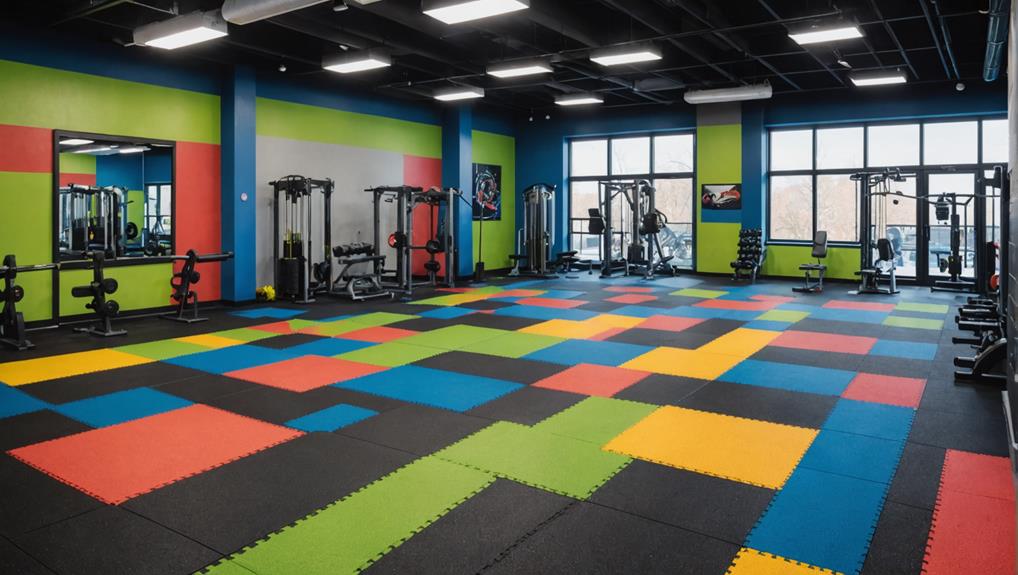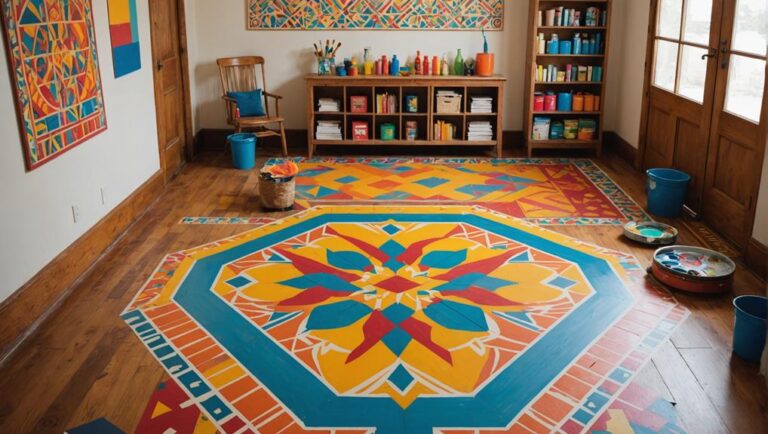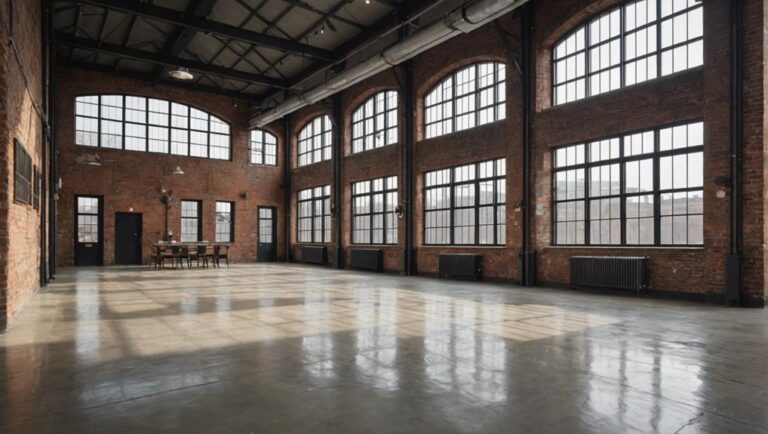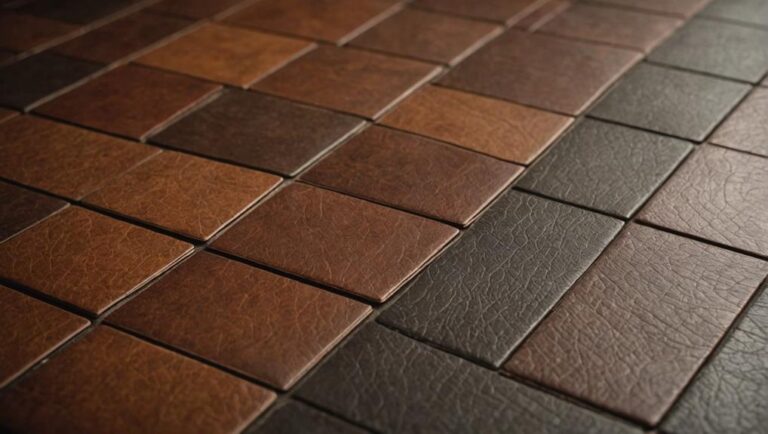Choosing the right flooring for your gym or sports facility is essential for enhancing performance and ensuring safety. Rubber flooring provides excellent shock absorption and traction, while vinyl surfaces are durable and ideal for high-impact activities. If you're interested in aesthetics, hardwood offers natural beauty but requires diligent maintenance. Turf can enhance agility and performance, making it great for indoor sports. Consider durability and maintenance costs, as quality materials are often more economical in the long run. Each option has unique benefits that can cater to your specific needs, and exploring further can help you make a more informed choice.
Importance of Flooring Selection
When you step onto a gym floor, the type of flooring beneath your feet can greatly impact your workout experience. Selecting the right flooring is essential for performance enhancement and maintaining safety standards. The flooring material you choose affects not only how well you can perform exercises but also how safely you can do them.
For instance, certain flooring options provide better shock absorption, reducing the risk of injuries from high-impact activities. If you're engaging in weightlifting or high-intensity interval training, it's important to have a surface that can absorb the stress of repetitive movements. Floors that lack adequate cushioning can lead to joint pain, fatigue, and increased susceptibility to injuries over time.
Moreover, flooring with high traction can prevent slips and falls, which are common hazards in gym environments. Ensuring that your gym flooring meets established safety standards is crucial for creating a secure workout space. This means looking for materials that have been tested for slip resistance, durability, and impact protection.
Choosing the right flooring doesn't just enhance your performance; it also plays a significant role in injury prevention. By prioritizing safety and performance in your flooring selection, you lay the groundwork for a more effective and enjoyable workout experience. Ultimately, the right gym flooring can elevate your training regimen while ensuring you stay safe and injury-free.
Types of Gym Flooring
When selecting gym flooring, you've got several options to evaluate. Rubber flooring offers excellent shock absorption and durability, while turf options provide versatility for functional training. Additionally, vinyl surfaces are known for their resilience and ease of maintenance, making them a popular choice for various gym environments.
Rubber Flooring Benefits
Rubber flooring offers several compelling benefits for gym environments, making it a popular choice among fitness facilities. One of the primary advantages is its safety features. Rubber flooring provides excellent traction, reducing the risk of slips and falls during high-intensity workouts. This is particularly essential in areas where sweat and moisture can create hazardous conditions.
Additionally, rubber flooring is highly durable and resilient, capable of withstanding heavy equipment and foot traffic without significant wear and tear. This longevity translates to lower maintenance costs over time, ensuring your investment remains sound.
From a comfort standpoint, rubber flooring offers a cushioned surface that can absorb impact, reducing strain on joints during workouts. This is especially beneficial for activities like weightlifting or high-impact aerobics.
Moreover, rubber flooring can contribute positively to gym aesthetics. Available in a variety of colors and styles, it can enhance the overall look of your facility while maintaining a professional appearance. This versatility allows you to create an inviting atmosphere that aligns with your brand's identity.
Turf Options Available
In addition to rubber flooring, turf options are gaining popularity in gym environments, particularly for functional training and athletic performance areas. You'll find that turf provides excellent surface traction and enhances player safety, making it a viable choice for a variety of sports activities.
When selecting turf, consider the following options:
- Artificial Turf: Offers durability and low maintenance, ideal for high-traffic areas.
- Natural Grass: Provides aesthetic appeal but requires more upkeep and a specific installation technique.
- Performance Enhancement: Certain turf types are specifically designed to improve agility and speed.
- Weather Resistance: Choose turf that withstands varying environmental conditions, ensuring year-round usability.
- Eco-Friendly Options: Many modern turf products offer sustainable materials, appealing to environmentally conscious facilities.
Cost comparison between turf and other flooring solutions shows that while initial installation may be higher, the long-term benefits, including reduced maintenance and increased durability, can offset those costs. Ultimately, selecting the right type of turf can considerably impact your gym's functionality and safety, making it an investment worth considering.
Vinyl Surface Durability
Vinyl flooring has become a favored choice for gyms due to its impressive durability and versatility. When it comes to vinyl performance, you'll find it stands up to heavy foot traffic and various fitness activities, making it ideal for both weightlifting and group classes. Its resistance to wear and tear is essential for maintaining safety standards in a gym environment.
Proper installation techniques play a significant role in maximizing the durability of vinyl surfaces. When correctly installed, these floors can prevent curling or lifting, which could pose tripping hazards. Furthermore, seamless installation options reduce the risk of bacteria and mold growth, ensuring a healthier space for athletes.
Additionally, the shock-absorbing properties of vinyl contribute to injury prevention by providing a softer landing surface. This can be particularly beneficial during high-impact activities like aerobics or plyometrics.
Rubber Flooring Benefits
Rubber flooring offers significant shock absorption properties, reducing the impact on joints during workouts. Its durability guarantees it withstands heavy use without compromising performance, making it ideal for high-traffic gym environments. Additionally, maintenance is straightforward, requiring minimal effort to keep it in peak condition.
Shock Absorption Properties
When it comes to flooring solutions for gyms, shock absorption is a critical factor that can greatly impact both performance and safety. Utilizing effective shock absorption techniques can reduce the risk of injuries, enhance athletic performance, and provide a comfortable training environment. Rubber flooring is particularly known for its exceptional shock-absorbing properties, making it a top choice for various sports facilities.
Here are some key benefits of rubber flooring related to shock absorption:
- Reduced Impact on Joints: Minimizes stress on knees and ankles during high-impact activities.
- Enhanced Traction: Offers stable footing, preventing slips and falls.
- Comfort: Provides a cushioned surface that supports prolonged workouts.
- Noise Reduction: Absorbs sound, creating a quieter gym atmosphere.
- Versatility: Suitable for multiple sports and fitness activities, from weightlifting to aerobics.
Incorporating rubber flooring in your gym can lead to significant performance enhancement while prioritizing safety. With its unique ability to absorb shock, rubber flooring guarantees that both you and your athletes can focus on achieving their best without the worry of undue strain or injury.
Durability and Maintenance
A high-quality flooring solution can considerably enhance the durability and maintenance of gym environments. Rubber flooring, in particular, is renowned for its exceptional wear resistance, making it ideal for high-traffic areas. This material withstands heavy equipment and foot traffic without showing significant signs of wear, ensuring your gym remains functional and safe over time.
In terms of maintenance, rubber flooring is a breeze. Routine cleaning typically involves just sweeping and mopping, allowing you to keep the space hygienic without extensive effort or specialized products. Unlike other flooring options, rubber doesn't require waxing or sealing, which can save you time and money in the long run.
Beyond its practical benefits, rubber flooring also offers aesthetic appeal. Available in various colors and patterns, it can enhance the visual appeal of your gym while providing a non-slip surface that promotes safety. This combination of durability, easy maintenance, and attractive design makes rubber flooring a top choice for gym owners aiming to create a safe and inviting environment.
Investing in high-quality rubber flooring is a smart decision for any sports facility, ensuring longevity and effortless upkeep while prioritizing the safety of your patrons.
Vinyl Flooring Advantages
One of the most compelling advantages of vinyl flooring for gyms is its remarkable durability, making it an ideal choice for high-traffic environments. This resilience not only withstands heavy foot traffic but also helps maintain safety standards, reducing the risk of slips and falls. When you opt for vinyl flooring, you're investing in a surface that can handle the demands of rigorous workouts and active sports.
Here are some key benefits that highlight why vinyl flooring is a smart choice for your facility:
- Enhanced Safety: Vinyl provides a slip-resistant surface, promoting safer workouts and minimizing accident risks.
- Versatile Design Aesthetics: With various colors and patterns, you can achieve the desired look while ensuring functionality.
- Easy Installation Techniques: Vinyl flooring can be installed quickly and efficiently, reducing downtime for your gym.
- Low Maintenance: Cleaning vinyl is straightforward, requiring only regular sweeping and occasional mopping, which keeps your facility hygienic.
- Cost-Effective: Compared to other flooring options, vinyl is often less expensive, both regarding initial investment and maintenance costs.
Choosing vinyl flooring not only meets the functional needs of your gym but also allows for creative design possibilities. With the right installation techniques, you can achieve a seamless look that enhances your space while prioritizing safety and durability. Ultimately, vinyl flooring combines practicality with aesthetic appeal, making it a top contender for any sports facility.
Hardwood Flooring Considerations
While hardwood flooring is often celebrated for its aesthetic appeal and classic look, there are several important considerations to keep in mind before making a decision for your gym. First, you'll want to evaluate the different hardwood types available, such as oak, maple, and cherry. Each type varies in durability, hardness, and maintenance requirements, which can greatly affect safety and performance. For instance, maple is a popular choice for sports facilities due to its resilient surface and shock absorption capabilities.
Next, consider the installation techniques. Proper installation is vital for ensuring the longevity and safety of your hardwood flooring. It is important to follow industry standards, such as using a moisture barrier to prevent warping and ensuring the subfloor is level. A floating installation might be beneficial for gyms, as it allows for slight movement and can help reduce stress on the flooring during high-impact activities.
Additionally, think about the maintenance required for hardwood floors. Regular cleaning is necessary to prevent slips and falls, which can occur if dust or moisture accumulates. You might also need to periodically refinish the surface to maintain its integrity and appearance.
Lastly, don't overlook the significance of proper cushioning under the hardwood. This can help alleviate stress on joints and reduce the risk of injury during athletic activities. By considering these factors, you can make an informed decision that enhances both the safety and aesthetics of your gym's environment.
Turf for Indoor Sports
When it comes to enhancing indoor sports facilities, turf offers a versatile and effective solution. It can serve multiple purposes, from hosting soccer and football practices to accommodating fitness classes. The right turf installation not only enhances performance but also guarantees safety for athletes. Here are some benefits of using turf in your facility:
- Durability: Turf is designed to withstand high levels of wear and tear, making it ideal for busy sports environments.
- Low Maintenance: Unlike natural grass, turf requires minimal upkeep, allowing you to focus on athletic training rather than constant care.
- Consistent Performance: With an even surface, turf provides reliable traction and cushioning, reducing the risk of injuries.
- Weather Resistance: Indoor turf isn't affected by weather conditions, guaranteeing that activities can continue year-round without interruptions.
- Versatility: You can easily customize turf layouts to accommodate various sports and training activities, maximizing your facility's utility.
To maintain your turf's integrity, regular turf maintenance is essential. This includes cleaning debris, monitoring for any damage, and guaranteeing proper drainage to prevent water pooling. Additionally, periodic inspections can help detect issues before they escalate, enhancing safety for users. By investing in quality turf installation and committing to diligent turf maintenance, you create a safe, efficient, and enjoyable environment for athletes of all levels.
Impact-Resistant Options
A variety of impact-resistant flooring options can greatly enhance the safety and functionality of gym spaces. When you're selecting flooring, it's crucial to take into account materials that meet safety standards to protect athletes and gym-goers from injuries caused by falls or heavy impacts. Options like rubber flooring, foam tiles, and vinyl surfaces are designed specifically to absorb shock, reducing the risk of injuries.
Rubber flooring, for example, is a popular choice due to its durability and versatility. It's available in rolls or tiles and can be used in various applications, from weightlifting areas to multi-purpose courts. When installed correctly using proper installation techniques, rubber flooring can provide a seamless surface that minimizes gaps where dirt or moisture could accumulate, enhancing hygiene and safety.
Foam tiles are another excellent option, particularly in areas designated for children or high-impact activities. They're lighter and easier to handle, making them suitable for temporary setups or multi-use spaces. It's important to guarantee that the foam tiles are interlocked tightly, as this helps maintain their integrity and prevents tripping hazards.
Maintenance and Care Tips
Selecting the right flooring is just the beginning; regular maintenance is vital to guarantee longevity and performance. Proper care guarantees that your gym flooring remains safe, functional, and visually appealing. Here are some essential maintenance and care tips to keep in mind:
- Regular Cleaning: Use appropriate cleaning techniques tailored to your flooring type. Daily sweeping or vacuuming helps remove debris that can cause scratches or damage.
- Deep Cleaning: Schedule periodic deep cleanings with specialized products that match your flooring material. This prevents buildup of dirt and grime.
- Surface Protection: Employ mats or protective coverings in high-traffic areas or under heavy equipment. This minimizes wear and tear, prolonging the life of your flooring.
- Moisture Control: Guarantee proper ventilation and control humidity levels. Excess moisture can lead to mold growth and damage, compromising safety.
- Inspection and Repair: Regularly inspect your flooring for signs of wear, such as cracks or lifting edges. Addressing issues promptly can prevent larger problems down the line.
Cost Factors to Consider
Cost factors play an essential role in determining the best flooring solution for your gym. When evaluating options, you'll need to account for various aspects that can greatly impact your budget. Installation costs are often one of the first things to take into account. Depending on the type of flooring you choose, these costs can vary greatly. For instance, rubber flooring might have a higher upfront cost, but its durability can lead to lower maintenance expenses over time.
Next, think about the long-term investments involved. While it may be tempting to go for the cheapest option, reflect on how that might affect safety and overall performance. High-quality flooring can provide better shock absorption and slip resistance, vital for reducing injury risks during workouts. Investing in a durable material can save you money in the long run, as it typically requires less frequent replacement.
Additionally, keep in mind that some flooring types may require specific installation techniques, which can add to your overall installation costs. Make sure to factor in these considerations when budgeting for your project. Always get quotes from reputable contractors and ask about warranties and after-sales support, as these can also affect your total cost.
Frequently Asked Questions
Can Flooring Affect Athlete Performance and Safety?
Absolutely, flooring can greatly influence athlete performance and safety. When conducting an impact assessment, you'll find that the right surface can enhance performance metrics like speed and agility. Conversely, inadequate flooring may increase injury risks, affecting overall safety. Materials with ideal shock absorption and traction will not only support athletic movements but also reduce strain on joints. Choosing the appropriate flooring is essential for maximizing both performance and athlete well-being.
How Often Should Gym Flooring Be Replaced?
Replacing gym flooring is like changing tires on a race car; it's essential for performance and safety. Generally, you should consider replacement every 5 to 10 years, depending on usage and maintenance frequency. High-traffic areas may wear faster, requiring more frequent evaluations. Cost considerations also play a role, as investing in durable flooring can extend lifespan and reduce long-term expenses. Prioritizing regular inspections guarantees athletes train safely and effectively on ideal surfaces.
What Are Eco-Friendly Flooring Options for Gyms?
When considering eco-friendly flooring options, you should explore sustainable materials like bamboo, cork, and recycled rubber. These materials not only minimize environmental impact but also provide safety benefits, like shock absorption. It's crucial to choose the right installation techniques, ensuring proper adhesion and minimizing emissions of harmful substances. By opting for these eco-conscious choices, you can create a healthier environment while maintaining durability and performance in your space.
Are There Specific Flooring Requirements for Different Sports?
When considering flooring requirements for different sports, you need to pay attention to court specifications, as each sport has unique demands. Impact absorption is essential for activities like basketball, while surface traction is important for sports like badminton. Additionally, maintenance needs vary; some surfaces require regular upkeep to guarantee safety and performance. You'll want to choose materials that meet these criteria to provide a safe and effective environment for athletes.
How Do I Choose a Flooring Color or Design?
When choosing a flooring color or design, consider aesthetic considerations and color psychology. Colors can influence mood and performance; for instance, blue promotes calmness, while red can energize. Make sure the chosen hue aligns with your facility's purpose and enhances safety—darker colors might mask dirt but can absorb heat. Always prioritize slip resistance and maintenance, as these factors are essential for creating a safe environment while also achieving the desired visual appeal.




